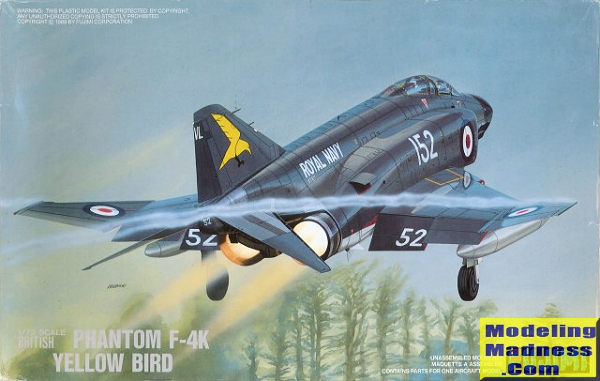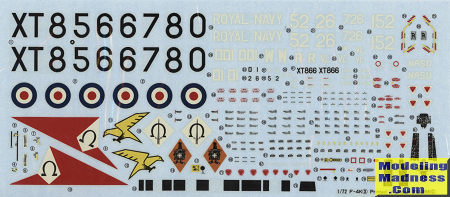
| KIT #: | 27019 |
| PRICE: | 1200 yen SRP |
| DECALS: | Four options |
| REVIEWER: | Scott Van Aken |
| NOTES: | 1989 boxing |

| HISTORY |
Unless you are really new to military airplanes, you know that the Phabulous Phantom is the greatest jet aircraft ever to take to the skies. It is true. Not only was it the mainstay of the US Navy, US Marine Corps, and the US Air Force for well over a decade, but it also served in a number of other nations around the world.
This kit is the British F-4K so it would be appropriate to have a bit of background on that version. The United Kingdom bought versions based on the U.S. Navy's F-4J for use with the Royal Air Force and the Royal Navy's Fleet Air Arm. The main differences were the use of the British Rolls-Royce Spey engines and of British-made avionics. The RN and RAF versions were given the designation F-4K and F-4M respectively, and entered service with the British military aircraft designations Phantom FG.1 (fighter/ground attack) and Phantom FGR.2 (fighter/ground attack/reconnaissance). Initially, the FGR.2 was used in the ground attack and reconnaissance role, primarily with RAF Germany, while 43 Squadron was formed in the air defence role using the FG.1s that had been intended for the Fleet Air Arm for use aboard HMS Eagle. The superiority of the Phantom over the English Electric Lightning in terms of both range and weapon load, combined with the successful introduction of the SEPECAT Jaguar, meant that, during the mid-1970s, most of the ground attack Phantoms in Germany were redeployed to the UK to replace air defence Lightning squadrons. A second RAF squadron, 111 Squadron, was formed on the FG.1 in 1979 after the disbandment of 892 NAS.
| THE KIT |
 When
Fujimi came out with their British Phantoms in the late 1980, they were much
welcomed by fans. At last, we had a modern Spey-powered 1/72 F-4. Unlike
their slightly earlier US Phantom series, this one had a nice cockpit that
actually fit well. It still used decals for instruments, but in this scale
it is not that big a deal for most.
When
Fujimi came out with their British Phantoms in the late 1980, they were much
welcomed by fans. At last, we had a modern Spey-powered 1/72 F-4. Unlike
their slightly earlier US Phantom series, this one had a nice cockpit that
actually fit well. It still used decals for instruments, but in this scale
it is not that big a deal for most.  Instructions
are well done with the usual Gunze paint references. All four markings
options are in extra dark sea grey over white. The extra dark sea grey
quickly faded so many will use just dark sea grey for this. The four units
are the box art squadron, 767 squadron, which did not last very long. The
other fleet unit was 892 which flew the plane until the Ark Royal was
decomissioned. The other two options are 700a Squadron which was a short
lived development unit and the Phantom Training Flight. Decals are nicely
printed, but will be a bit thick and may not be viable if they are too old.
There are aftermarket replacements if one wants.
Instructions
are well done with the usual Gunze paint references. All four markings
options are in extra dark sea grey over white. The extra dark sea grey
quickly faded so many will use just dark sea grey for this. The four units
are the box art squadron, 767 squadron, which did not last very long. The
other fleet unit was 892 which flew the plane until the Ark Royal was
decomissioned. The other two options are 700a Squadron which was a short
lived development unit and the Phantom Training Flight. Decals are nicely
printed, but will be a bit thick and may not be viable if they are too old.
There are aftermarket replacements if one wants.
| CONCLUSIONS |
Bottom line is that this is still the best British F-4 in this scale and well worth the effort of picking up if you find one at a reasonable price.
| REFERENCES |
https://en.wikipedia.org/wiki/McDonnell_Douglas_F-4_Phantom_II#United_Kingdom
February 2017
Copyright ModelingMadness.com. All rights reserved.
Thanks to me for picking this one up when it was on sale.
If you would like your product reviewed fairly and quickly, please contact the editor or see other details in the Note to Contributors.